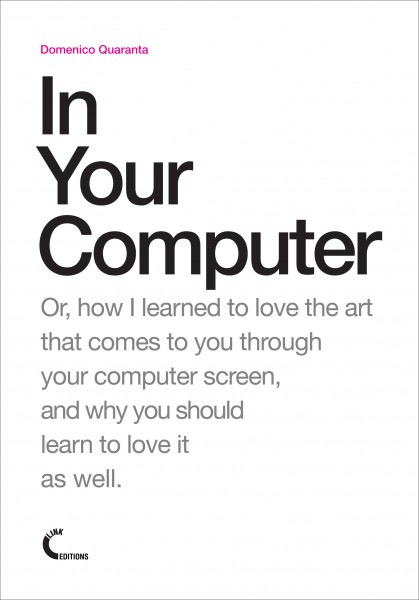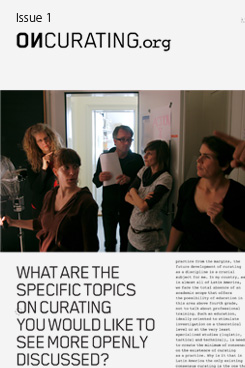Domenico Quaranta: In Your Computer (2011)
Filed under book | Tags: · art, biotechnology, curating, internet, interview, media art, media theory, net art, new media, software art, technology, video games

This book is a collection of texts written by Domenico Quaranta between 2005 and 2010 for exhibition catalogues, printed magazines and online reviews: a pocket version of what the author would save from the universal flood, in a world without computers. It documents most of the fields of research he has focused on critically: from Net Art to Software Art and videogames, from biotechnologies to the debate around curating and the positioning of New Media Art in the contemporary landscape, and back to Net Art again.
This itinerary is traced through a selection of essays, monographic texts and interviews with artists and curators, in no particular order: from Eva and Franco Mattes to Casey Reas, from UBERMORGEN.COM to Oliver Laric, from Cory Arcangel to Tale of Tales, from Jon Ippolito to Gazira Babeli.
As the author writes in the introduction: «We are in the midst of a major change. At the end of the process, not only the way we live, work, travel and communicate, but also the political and economical structures and the social organization we are used to will probably be fundamentally different from how they are now. In art, this change will be complete when the way we make, circulate and understand art is completely different from the way we do it now; and when the way we understand the difference between copies and original and between art and non-art will have adapted to the new models created by the information age. The most we can do now is to take our time, adapt to our new living conditions, be aware of the process going on and look to the most radical propositions around for signals of what is to come. In the awareness that we probably don’t have to look that far: these signals are already here, in our computers.»
Translation and editing: Anna Rosemary Carruthers
Publisher: LINK Editions, Brescia 2011.
ISBN: 978-1-4467-6021-5
180 pages
Licensed under the Creative Commons Attribution-NonCommercial-ShareAlike 3.0 Unported License.
publisher
lulu.com
via Domenico Quaranta
OnCurating (2008–)
Filed under journal | Tags: · art, art criticism, contemporary art, curating

oncurating.org is an independent international journal (both web and print) focusing on questions around curatorial practise and theory.
Publisher: Dorothee Richter, with Michael Birchall, Zürich
Concept: Dorothee Richter in cooperation with Maren Brauner, Johanna Franco Bernet, Barnaby Drabble, Irene Grillo, Petra Haider, Damian Jurt, Christoph Kern, Wolf Schmelter, Thomas Zacharias.
Open Access
MIT Comparative Media Studies student theses (2001-2008)
Filed under thesis | Tags: · cartography, curating, data visualisation, internet art, media culture, net art, politics
AMANDA FINKELBERG
Space, Place, and Database: Digital Cartography in the Network Age (2007)
This paper addresses the changes in cartography since digitization and widespread popular dissemination. Cybercartography, an emergent system of maps, mapmaking tools, and mapmakers, forces a rethinking of spatial representations. The implicit distinction in digital media enables a new type of map user or neo-geographer that creates layers of expressions based on subjective experience. This paper argues that the neogeographer signifies a new cartographic behavior that affords a complex subjectivity. This behavior is further exhibited in the practice of navigable maps and virtual globes which lead the way to a paradigmatic change in the way we represent and interact with space. It is divided into three parts: Part I addresses the role of digitization in maps and lays out framework and vocabulary. Part II examines layers of spatial representations in historical context. Part III opens room for future study in the quickly developing inhabitable cartographic spaces of virtual globes and virtual worlds.
PDF
KAREN VERSCHOOREN
.art: situating internet art in the modern museum (2007)
This thesis provides a critical analysis of the relation between Internet art and the traditional institution for contemporary art in the North American and West-European regions. Thirteen years after its inception as an art form, the Internet art world finds itself in a developmental stage and its relation to the traditional institution for contemporary art is accordingly. Through an elaborate discussion of the key players, institutions and discourses on aesthetics, economics and exhibition methodologies, this sociological analysis of the past and current situation hopes to offer a solid ground for extrapolation and predictions for Internet art’s future as an art world in its relation to the traditional art institutions.
PDF
STEPHANIE DAVENPORT
Experiments in Corporate Collaboration: The Case of the Ars Electronica FutureLab (2003)
PDF
SOPHIE ORMEROD
The Medium Still Isn’t the Message: Revisiting the Link Between Communication Technologies and Political Liberalization (2002)
PDF

